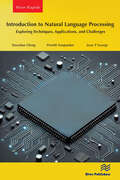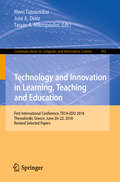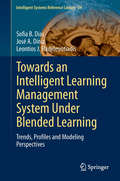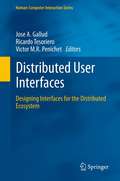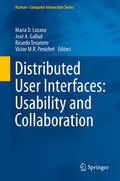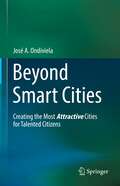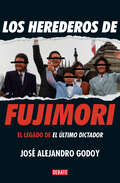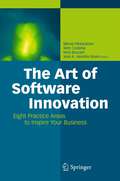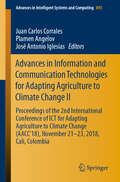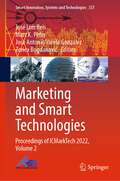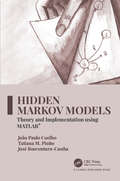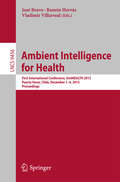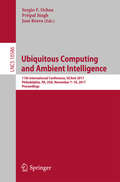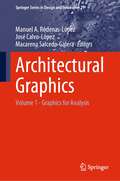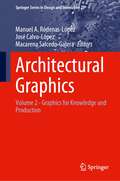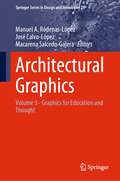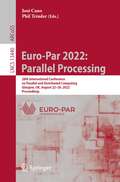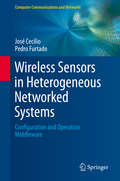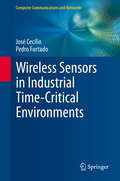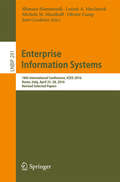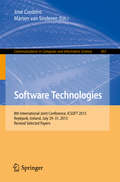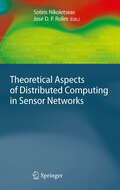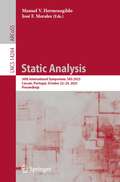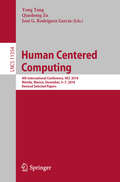- Table View
- List View
Introduction to Natural Language Processing: Exploring Techniques, Applications, and Challenges (River Publishers Series in Rapids in Computing and Information Science and Technology)
by Xiaochun Cheng Preethi Nanjundan Jossy P GeorgeThis book provides a thorough and comprehensive introduction to natural language processing (NLP), a critical field at the intersection of artificial intelligence and computational linguistics. It explores key techniques such as sentiment analysis, which enables the detection of emotional tone in text, machine translation, facilitating the conversion of text between languages, and named entity recognition (NER), which identifies and classifies entities like names, dates, and locations within text data.The book delves into deep learning advancements, particularly the use of neural networks such as transformers and recurrent models, which have revolutionized NLP applications. Readers will gain insights into how these models drive innovations in areas such as text classification, language generation, and speech recognition.In addition to technical concepts, the book also addresses the ethical considerations surrounding NLP, emphasizing the responsible use of AI technologies to mitigate issues like bias, misinformation, and privacy concerns. Practical case studies and real-world examples are included to illustrate how NLP is applied in various sectors, including healthcare, finance, and customer service.This book is an invaluable resource for students, researchers, and industry professionals seeking to understand the foundational concepts, cutting-edge advancements, and broader implications of NLP, equipping them with the knowledge to innovate and apply these technologies effectively in their respective fields.
Technology and Innovation in Learning, Teaching and Education: First International Conference, TECH-EDU 2018, Thessaloniki, Greece, June 20–22, 2018, Revised Selected Papers (Communications in Computer and Information Science #993)
by José A. Diniz Meni Tsitouridou Tassos A. MikropoulosThis book constitutes the thoroughly refereed post-conference proceedings of the First International Conference on Technology and Innovation in Learning, Teaching and Education, TECH-EDU 2018, held in Thessaloniki, Greece, on June 20-22, 2018. The 30 revised full papers along with 18 short papers presented were carefully reviewed and selected from 80 submissions.The papers are organized in topical sections on new technologies and teaching approaches to promote the strategies of self and co-regulation learning (new-TECH to SCRL); eLearning 2.0: trends, challenges and innovative perspectives; building critical thinking in higher education: meeting the challenge; digital tools in S and T learning; exploratory potentialities of emerging technologies in education; learning technologies; digital technologies and instructional design; big data in education and learning analytics.
Towards an Intelligent Learning Management System Under Blended Learning
by Sofia B. Dias José A. Diniz Leontios J. HadjileontiadisWhat are the key channels to change in blended instructional practice as they relate to the use of a learning management system (LMS)? What role LMS users' profiles play in facilitating change in practice? Can we model users' quality of interaction (QoI) with LMS? How inclusiveness and affectiveness could lead to a personalized intelligent LMS (iLMS)? If these questions sound intrinsic to you and to your own experience and circumstance, then this book fits absolutely to you. Here, the term Blended - viewed as a fuzzy concept - is understood as a stepping-stone on the way to the future, to explain the multiple ways human beings think/act/feel of society in the 21st century and to embrace the opportunity of humans to re/co-construct new knowledge through the intermediation role of the technology. Initially, based on an online learning environment' theoretical framework, some current issues of the educational processes in the digital age of Web 2. 0 are analyzed. Then, after exploring the main methodological procedures, characteristic examples of research case studies follow, including LMS users' trends and profiles and modeling of their QoI using fuzzy logic. This book offers useful information that evokes initiatives towards rethinking of the value, efficiency, inclusiveness, affectiveness and personalization of the iLMS-based b-learning environment, both by the educators, the LMS designers and educational policy decision makers.
Distributed User Interfaces
by José A. Gallud Victor M.R. Penichet Ricardo TesorieroThe recent advances in display technologies and mobile devices is having an important effect on the way users interact with all kinds of devices (computers, mobile devices, laptops, tablets, and so on). These are opening up new possibilities for interaction, including the distribution of the UI (User Interface) amongst different devices, and implies that the UI can be split and composed, moved, copied or cloned among devices running the same or different operating systems. These new ways of manipulating the UI are considered under the emerging topic of Distributed User Interfaces (DUIs). DUIs are concerned with the repartition of one of many elements from one or many user interfaces in order to support one or many users to carry out one or many tasks on one or many domains in one or many contexts of use - each context of use consisting of users, platforms, and environments. The 20 chapters in the book cover between them the state-of-the-art, the foundations, and original applications of DUIs. Case studies are also included, and the book culminates with a review of interesting and novel applications that implement DUIs in different scenarios.
Distributed User Interfaces: Usability and Collaboration
by José A. Gallud Ricardo Tesoriero María D. Lozano Víctor M. R. PenichetWritten by international researchers in the field of Distributed User Interfaces (DUIs), this book brings together important contributions regarding collaboration and usability in Distributed User Interface settings. Throughout the thirteen chapters authors address key questions concerning how collaboration can be improved by using DUIs, including: in which situations a DUI is suitable to ease the collaboration among users; how usability standards can be used to evaluate the usability of systems based on DUIs; and accurately describe case studies and prototypes implementing these concerns. Under a collaborative scenario, users sharing common goals may take advantage of DUI environments to carry out their tasks more successfully because DUIs provide a shared environment where the users are allowed to manipulate information in the same space and at the same time. Under this hypothesis, collaborative DUI scenarios open new challenges to usability evaluation techniques and methods. Distributed User Interfaces: Collaboration and Usability presents an integrated view of different approaches related to Collaboration and Usability in Distributed User Interface settings, which demonstrate the state of the art, as well as future directions in this novel and rapidly evolving subject area.
Beyond Smart Cities: Creating the Most Attractive Cities for Talented Citizens
by José A. OndivielaCities are experiencing unprecedented times. In addition of managing the best possible post-pandemic recovery, Cities are at the beginning of the 4th industrial revolution, and all want to play a relevant role in it. To achieve this, they must retain and attract the necessary talent. There is a fierce competition where cities transform to become as attractive as possible. But what makes a city attractive (from emotional and rational sides) to talented citizens? For mayors and city directors: how can I prepare my city for this goal? What kind of transformations in the medium-long term should I develop? And in the short term, what processes and technologies (SmartCity) should I put in place? And from the point of view of citizens: how do I choose the best city to develop my full potential? Which one offers me the best citizenship contract? Where am I going to enjoy the best services with the highest quality of life and lower taxes/cost of life? In addition, the city must be attractive, with a strong identity and dynamism and promising future. Can I find the cities that best suit my aesthetic and emotional preferences, and that also offer me the services that I consider a priority at the lowest cost to my pocket? Find all the answers in this book.
Los herederos de Fujimori: El legado de El último dictador
by José Alejandro GodoyEl periodista José Alejandro Godoy regresa con un nuevo libro despúes de El último dictador. En Los herederos de Fujimori, nos presenta una exhaustiva investigación bibliográfica y periodística sobre la vida política de sus dos descendientes y otros personajes de la política peruana. En el contundente El último dictador, José Alejandro Godoy elaboró un relato pormenorizado de la larga década de autoritarismo, violencia y corrupción que tuvo como protagonista a Alberto Fujimori. En esta ocasión, la tarea emprendida en Los herederos de Fujimori es todavía más ambiciosa: abarcar más de veinte años de historia política que, inevitablemente, han estado marcados a sangre y fuego por el linaje de nuestro último dictador. Mediante un exhaustivo trabajo de investigación bibliográfica y periodística, Godoy recorre un vertiginoso período de la historia peruana en el que la herencia fujimorista no solo se ha manifestado en la omnipresencia de dos de sus descendientes en la vida política del país, sino también en los modales (poco) democráticos, las fórmulas populistas y la propensión a los escándalos —de toda índole— que caracterizaron los mandatos de prácticamente todos sus sucesores en Palacio de Gobierno. Alejandro Toledo, Alan García, Ollanta Humala, Martín Vizcarra, Pedro Pablo Kuczynski y Keiko Fujimori son algunos de los personajes recurrentes en esta historia, pero no los únicos. Entre desastres naturales (y de los otros), presidencias truncas, sobornos millonarios, asilos, indultos y carcelerías de alto vuelo, queda claro que el Perú es un territorio signado por la incombustible flama de un tambaleante quehacer político. Este libro recupera la memoria de los últimos años, y revela un país que aún lucha por encontrar un mejor destino.
The Art of Software Innovation: Eight Practice Areas to Inspire your Business
by Nick Boucart Wim Codenie Minna Pikkarainen José Antonio Heredia AlvaroImagine that you are the CEO of a software company. You know you compete in an environment that does not permit you to treat innovation as a secondary issue. But how should you manage your software innovation to get the most out of it? This book will provide you with the answer. Software innovation is multifaceted and the approaches used by companies can be very different. The team of authors that wrote this book took the assumption that there is no such thing as a universal software engineering process or innovation process. Some things work well for a certain company, others do not. The book is organized around what the authors call eight fundamental practice areas for innovation with software. Each practice area contains a number of activities that can help companies to master that practice area. It also contains industrial experience reports that illustrate the applicability of these practice areas in software companies and is structured in such a way that you can select and read only those practice areas that are relevant to your company. The book is written with an industrial target audience in mind. Its most important goal is to challenge companies by offering them a framework to become more innovation-driven, rather than engineering-driven. Intrigued? Here you will find details of what you and your company can do to understand, implement, and sustain continuous innovation.
Advances in Information and Communication Technologies for Adapting Agriculture to Climate Change II: Proceedings of the 2nd International Conference of ICT for Adapting Agriculture to Climate Change (AACC'18), November 21-23, 2018, Cali, Colombia (Advances in Intelligent Systems and Computing #893)
by Plamen Angelov Juan Carlos Corrales José Antonio IglesiasThis book presents novel communication technology solutions to address the effects of climate change and climate variability on agriculture, with a particular focus on those that increase agricultural production. It discusses decision support and early warning systems for agriculture; information technology (IT) supporting sustainable water management and land cover dynamics; predictive of crop production models; and software applications for reducing the effects of diseases and pests on crops. Further topics include the real-time monitoring of weather conditions and water quality, as well as food security issues. Featuring the proceedings of the International Conference of ICT for Adapting Agriculture to Climate Change (AACC’18), held on November 21–23, 2018, in Cali, Colombia, the book represents a timely report and a source of new ideas and solutions for both researchers and practitioners active in the agricultural sector around the globe.
Marketing and Smart Technologies: Proceedings of ICMarkTech 2022, Volume 2 (Smart Innovation, Systems and Technologies #337)
by José Luís Reis Marc K. Peter Zorica Bogdanović José Antonio Varela GonzálezThis book includes selected papers presented at the International Conference on Marketing and Technologies (ICMarkTech 2022), held at Universidade de Santiago de Compostela, Spain, during December 1–3, 2022. It covers up-to-date cutting-edge research on artificial intelligence applied in marketing, virtual and augmented reality in marketing, business intelligence databases and marketing, data mining and big data, marketing data science, web marketing, e-commerce and v-commerce, social media and networking, geomarketing and IoT, marketing automation and inbound marketing, machine learning applied to marketing, customer data management and CRM, and neuromarketing technologies.
Hidden Markov Models: Theory and Implementation using MATLAB®
by José Boaventura-Cunha João Coelho Tatiana PinhoThis book presents, in an integrated form, both the analysis and synthesis of three different types of hidden Markov models. Unlike other books on the subject, it is generic and does not focus on a specific theme, e.g. speech processing. Moreover, it presents the translation of hidden Markov models’ concepts from the domain of formal mathematics into computer codes using MATLAB®. The unique feature of this book is that the theoretical concepts are first presented using an intuition-based approach followed by the description of the fundamental algorithms behind hidden Markov models using MATLAB®. This approach, by means of analysis followed by synthesis, is suitable for those who want to study the subject using a more empirical approach. <p><P>Key Selling Points: <li>Presents a broad range of concepts related to Hidden Markov Models (HMM), from simple problems to advanced theory <li>Covers the analysis of both continuous and discrete Markov chains <li>Discusses the translation of HMM concepts from the realm of formal mathematics into computer code <li>Offers many examples to supplement mathematical notation when explaining new concepts
Ambient Intelligence for Health: First International Conference, AmIHEALTH 2015, Puerto Varas, Chile, December 1-4, 2015, Proceedings (Lecture Notes in Computer Science #9456)
by Ramón Hervás José Bravo Vladimir VillarrealThis book constitutes the refereed conference proceedingsof the First International Conference on Ambient Intelligence for Health,AmIHEALTH 2015, held in Puerto Varas, Chile, in December 2015. The 20 revised full papers and 9 short papers werereviewed and selected from 32 submissions and cover topics on technologies forimplementing AmIHealth environments; frameworks related with AmIHealthenvironments; applied algorithms in e-Health systems; interactions within theAmIHealth environments; applications and case studies of AmIHealthenvironments; and metrics for health environments.
Ubiquitous Computing and Ambient Intelligence
by Pritpal Singh José Bravo Sergio F. OchoaThis book constitutes the refereed conference proceedings of the 11th International Conference on Ubiquitous Computing and Ambient Intelligence, UCAmI 2017, held in Philadelphia, PA, USA in November 2017. The 60 revised full papers and 22 short papers presented were carefully reviewed and selected from 100 submissions. The papers are presented in six tracks and two special sessions. These are Ambient Assisted Living, Human-Computer Interaction, Ambient Intelligence for Health, Internet of Things and Smart Cities, Ad-hoc and Sensor Networks, Sustainability, Socio-Cognitive and Affective Computing, AmI-Systems and Machine Learning.
Architectural Graphics: Volume 1 - Graphics for Analysis (Springer Series in Design and Innovation #21)
by José Calvo-López Manuel A. Ródenas-López Macarena Salcedo-GaleraThis book reports on several advances in architectural graphics, with a special emphasis on education, training, and research. It gathers a selection of contributions to the 19th International Conference on Graphic Design in Architecture, EGA 2022, held on June 2–4, 2022, in Cartagena, Spain, with the motto: "Beyond drawings. The use of architectural graphics".
Architectural Graphics: Volume 2 - Graphics for Knowledge and Production (Springer Series in Design and Innovation #22)
by José Calvo-López Manuel A. Ródenas-López Macarena Salcedo-GaleraThis book reports on several advances in architectural graphics, with a special emphasis on education, training and research. It gathers a selection of contributions to the 19th International Conference on Graphic Design in Architecture, EGA 2022, held on June 2–4, 2022, in Cartagena, Spain, with the motto: "Beyond drawings. The use of architectural graphics".
Architectural Graphics: Volume 3 - Graphics for Education and Thought (Springer Series in Design and Innovation #23)
by José Calvo-López Manuel A. Ródenas-López Macarena Salcedo-GaleraThis book reports on several advances in architectural graphics, with a special emphasis on education, training and research. It gathers a selection of contributions to the 19th International Conference on Graphic Design in Architecture, EGA 2022, held on June 2–4, 2022, in Cartagena, Spain, with the motto: "Beyond drawings. The use of architectural graphics".
Euro-Par 2022: 28th International Conference on Parallel and Distributed Computing, Glasgow, UK, August 22–26, 2022, Proceedings (Lecture Notes in Computer Science #13440)
by Phil Trinder José CanoThis book constitutes the proceedings of the 33rd International Conference on Parallel and Distributed Computing, Euro-Par 2022, held in Vienna, Austria, in August 2022.The 25 full papers presented in this volume were carefully reviewed and selected from 102 submissions. The conference Euro-Par 2022 covers all aspects of parallel and distributed computing, ranging from theory to practice, scaling from the smallest to the largest parallel and distributed systems, from fundamental computational problems and models to full-fledged applications, from architecture and interface design and implementation to tools, infrastructures and applications.
Wireless Sensors in Heterogeneous Networked Systems
by José Cecílio Pedro FurtadoThis book presents an examination of the middleware that can be used to configure and operate heterogeneous node platforms and sensor networks. The middleware requirements for a range of application scenarios are compared and analysed. The text then defines middleware architecture that has been integrated in an approach demonstrated live in a refinery. Features: presents a thorough introduction to the major concepts behind wireless sensor networks (WSNs); reviews the various application scenarios and existing middleware solutions for WSNs; discusses the middleware mechanisms necessary for heterogeneous WSNs; provides a detailed examination of platform-agnostic middleware architecture, including important implementation details; investigates the programming paradigms for WSNs, and for heterogeneous sensor networks in general; describes the results of extensive experimentation and testing, demonstrating that the generic architecture is viable for implementation on multiple platforms.
Wireless Sensors in Industrial Time-Critical Environments
by José Cecílio Pedro FurtadoThis book introduces the fundamentals of DCS, and shows how to include wireless technology in their design while guaranteeing the desired operation characteristics. The text also presents insights and results gained from extensive practical experience in implementing and testing systems within a specific industrial setting. Features: examines the operations that the DCS implements, covering human-machine interfaces, diagnostics and maintenance interfaces, and controllers; discusses industrial control system and wireless network protocols; reviews scheduling in wireless sensor networks; describes a latency model for heterogeneous DCS with wired and wireless parts, that predicts monitoring, command, and closed loop latencies; explains how to plan operation timings systematically; introduces measures and metrics for performance monitoring and debugging, and describes how to add these to a system; presents experimental results to validate the planning approach, based on an application test-bed.
Enterprise Information Systems
by Leszek A. Maciaszek Slimane Hammoudi Olivier Camp José Cordeiro Michele M. MissikoffThis book comprises a set of papers selected from those presented at the fifth #65533; International Conference on Enterprise Information Systems #65533;, (ICEIS'2003) held in Angers, France, from 23 to 26 April 2003. The conference was organised by #65533;cole Sup#65533;rieure d'#65533;lectronique de l'Ouest (ESEO) of Angers, France and the Escola Superior de Tecnologia of Set#65533;bal, Portugal. Since its first edition in 1999, ICEIS focuses on real world applications and aims at bringing together researchers, engineers and practitioners interested in the advances and business applications of information systems. As in previous years, ICEIS'2003 held four simultaneous tracks covering different aspects of enterprise computing: Databases and Information Systems Integration, Artificial Intelligence and Decision Support Systems, Information Systems Analysis and Specification and Software Agents and Internet Computing. Although ICEIS'2003 received 546 paper submissions from over 50 countries, only 80 were accepted as full papers and presented in 30-minutes oral presentations. With an acceptance rate of 15%, these numbers demonstrate the intention of preserving a high quality forum for future editions of this conference. From the articles accepted as long papers for the conference, only 32 were selected for inclusion in this book Additional keynote lectures, tutorials and industrial sessions were also held during ICEIS'2003, and, for the first time this year, the 1st Doctoral Consortium on Enterprise Information Systems gave PhD students an opportunity to present their work to an international audience of experts in the field of information systems.
Software Technologies
by Marten Van Sinderen José CordeiroThis book constitutes the thoroughly refereed proceedings of the 8th International Joint Conference on Software Technologies, ICSOFT 2013, held in Reykjavik, Iceland, in July 2013. The 19 revised full papers presented were carefully reviewed and selected from 121 paper submissions. The papers focus on the following research topics and applications: new software paradigm trends and mainstream software engineering and applications.
Software Technologies: 8th International Joint Conference, ICSOFT 2013, Reykjavik, Iceland, July 29-31, 2013, Revised Selected Papers (Communications in Computer and Information Science #457)
by José Cordeiro and Marten van SinderenThis book constitutes the thoroughly refereed proceedings of the 8th International Joint Conference on Software Technologies, ICSOFT 2013, held in Reykjavik, Iceland, in July 2013. The 19 revised full papers presented were carefully reviewed and selected from 121 paper submissions. The papers focus on the following research topics and applications: new software paradigm trends and mainstream software engineering and applications.
Theoretical Aspects of Distributed Computing in Sensor Networks
by José D.P. Rolim Sotiris NikoletseasWireless ad hoc sensor networks has recently become a very active research subject. Achieving efficient, fault-tolerant realizations of very large, highly dynamic, complex, unconventional networks is a real challenge for abstract modelling, algorithmic design and analysis, but a solid foundational and theoretical background seems to be lacking. This book presents high-quality contributions by leading experts worldwide on the key algorithmic and complexity-theoretic aspects of wireless sensor networks. The intended audience includes researchers and graduate students working on sensor networks, and the broader areas of wireless networking and distributed computing, as well as practitioners in the relevant application areas. The book can also serve as a text for advanced courses and seminars.
Static Analysis: 30th International Symposium, SAS 2023, Cascais, Portugal, October 22–24, 2023, Proceedings (Lecture Notes in Computer Science #14284)
by José F. Morales Manuel V. HermenegildoThis book constitutes the refereed proceedings of the 30th International Symposium on Static Analysis, SAS 2023, held in Lisbon, Portugal, in October 2023. The 20 full papers included in this book were carefully reviewed and selected from 40 submissions. Static analysis is widely recognized as a fundamental tool for program verification, bug detection, compiler optimization, program understanding, and software maintenance. The papers deal with theoretical, practical and application advances in the area.
Human Centered Computing: 4th International Conference, HCC 2018, Mérida, Mexico, December, 5–7, 2018, Revised Selected Papers (Lecture Notes in Computer Science #11354)
by Qiaohong Zu Yong Tang José G. Rodríguez GarcíaThis book constitutes thoroughly reviewed, revised and selected papers from the 4th International Conference on Human Centered Computing, HCC 2018, held in Merida, Mexico, in December 2018. The 50 full and 18 short papers presented in this volume were carefully reviewed and selected from a total of 146 submissions. They focus on a "hyper-connected world", dealing with new developments in artificial intelligence, deep learning, brain-computing, etc.
